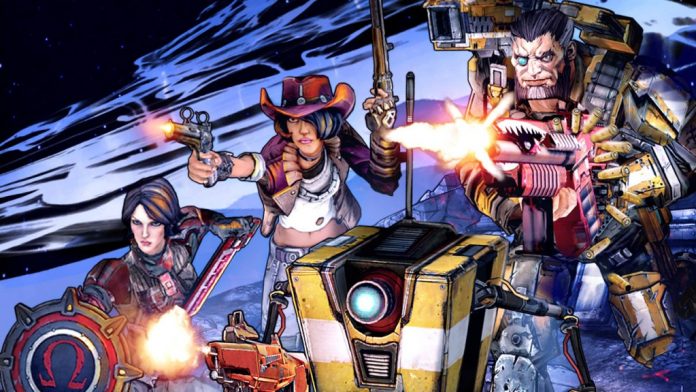Borderlands: The Pre-Sequel is the third game under the Borderlands name, but is primarily developed by 2K Australia this time around, with the original Dallas-based developer Gearbox Software only lending a helping hand. For those of you unfamiliar with the franchise, Borderlands is a loot-based FPS action RPG. In English, Borderlands is a first person shooter centered around finding bigger, better, and weirder guns by completing quests given to you by hilarious, odd, and downright morbid characters that populate the world. If you are new to Borderlands, I strongly suggest that the Pre-Sequel not be your first game in the series, as it takes place between the events of Borderlands 1 and Borderlands 2, requiring competent knowledge of both games to even have the slightest clue of what is happening. While the first game is still the optimal place to jump into the universe, the second does a good job of catching the player up with the story. Veterans of the series, however, will have no trouble diving back into the chronicles of the vault hunters.
The Pre-Sequel exists not as a continuation of the franchise, but more as a bridge that fleshes out what has already been presented in the first two games. Because of this, much criticism has been directed toward the Pre-Sequel as a simple money grab or glorified DLC that serves no purpose, and will only degrade the reputation that the beloved saga has built. This raises a heavily contended question: “How much does a game need to change between iterations?”
Gameplay:
As I said before, the Pre-Sequel does not depart from the loot-based gameplay of its predecessors. At its core, the game is driven by the desire to get more “stuff”. While it may sound materialistic, Borderlands lets people safely indulge in their innate desire for substance in a virtual world rather than obsess over goods in the real world. With five basic levels of rarity, there is a constant itch to obtain the next level of gear that keeps you playing. It is almost impossible to keep using the same piece of loot for an extended period of time, as every gun, shield, grenade mod, etc. that you find is randomly generated. While something you find might not be a full rarity level higher than what you currently have, it can still be marginally, or even significantly better. This constant gear swapping causes your style of play to be in perpetual flux in order to best utilize the items you currently have. Very seldom is an item simply better than the one you currently possess; there are always trade-offs. Of course, none of this would matter if using your loot was as fun as watching paint dry. Gladly, it’s not.
Though it may not be as smooth and polished as games like Destiny, the shooting mechanics still hold strong and get the job done. With the game based mostly around the stats of items, skills such as controlling recoil and finding cover do not hold paramount importance, leading to a very brazen, “run and gun” style of attack that contrasts monotonous cover-to-cover shootouts. However, the biggest changes in gameplay come down to what kind of character you play as, which dictates what sort of skills and abilities you can use in combat. The developers have even released online skill trees so you can plan your character out ahead of time: http://tinyurl.com/lczxjkx. Unique to the Pre-Sequel are the four new characters you can choose from at the start of the game, and the addition of O2 as a resource, as the game takes place on a moon with no atmosphere. With the low gravity environment, players are able to jump quite high into the air and either use a blast of their O2 to boost themselves in a direction or perform a ground-pound type move dubbed the “Butt-Slam!” These benefits come at a cost, though, as the player must have O2 to breathe or else they lose health. The reduction in health from oxygen loss is very forgiving, and I never found myself without ways to get more O2 through either canister drops from enemies or natural geysers. I feel like 2K Australia dropped the ball a bit when it came to this mechanic; health reduction should either be forgiving if you run out of O2 or O2 should be plentiful, not both. The mechanic here becomes a minor annoyance rather than a challenge. With only the addition of O2, a few new characters, and laser weapons (which are fairly self-explanatory and only add a bit more variety to the already extensive choice in guns), the Pre-Sequel walks the line between justified and unjustified in terms of innovation. The fact that it doesn’t claim to be a full successor to the previous games alongside the new level of verticality in the gameplay leads me to think that, gameplay-wise, this game has been able to innovate enough.
Narrative:
To me, the biggest draw of the Borderlands series is the writing which possesses a sense of humor like no other game. Simply put, it is one of the only games that can truly make me laugh, not just smirk, not blow air through my nostrils, but a actually laugh. With the same writers as the previous two installments, I knew exactly what to expect going into the game. Honestly, I would be tempted to buy the Pre-Sequel for the quality of voice acting and writing alone. In particular, Dameon J. Clarke, the voice of Handsome Jack, does some of the best voice acting I have ever heard in a game, and returns with another performance on par with his work in Borderlands 2. The characters are the driving force behind the humor with over the top personas and odd quirks that go unexplained. As has been a trademark of the series, the Pre-Sequel is filled to the brim with different references, but this time around, I noticed a slight increase in the number of jokes directed at social commentary. While I only caught two or three after getting seven hours into the game, all seemed odd, out of place, and a bit forced. In addition to this, the nature of these remarks confused me because I do not know how deep the sarcasm and satire goes. I am unsure if the game is itself being preachy or rather mocking those who are. I want to reiterate that these were small remarks by the characters that some people may not even catch, so this is generally not a huge deal. As a side note, I found it odd at first that everyone one the moon was Australian, but I then realized that in almost every other video game, the majority of characters are American. I hope to see more games in the future focus on differing cultures and utilize their unique slang and traits to freshen up the experience.
Visuals:
Unlike the majority of the shooters on the market today, Borderlands keeps away from the quest for “ultra-realistic” graphics in favor of a comic book-esque aesthetic that gives it a unique look distinct to the franchise. In addition to this, they also avoid the pitfall of desaturation that has been making games look grey and washed out as of late. Though it is a moon, the world the player explores is full of color and contrast. If you have played Borderlands 2, than you will notice almost no distinction between it and the Pre-Sequel visually, which can be taken as both good and bad. While there is very little 2K Australia could have done to the aesthetic without alienating the fan base, I would have liked the addition of higher resolution textures and more detailed visual effects. They essentially didn’t dare mess with a winning formula which preserved the aesthetic, but sadly ignored some of the necessary upkeep. The comic book aesthetic ties in perfectly with the type of humor the game is centered around and gives characters a personality before they even say a word. Ultimately, I can only explain so much in words, so if you are interested, I urge you to watch some of the trailers for the game and get a feel for the world for yourself.
Conclusion:
Looking back on the question raised, I believe the Pre-Sequel walks a fine line, just barely slipping by the requirements to consider itself a legitimate installment of the Borderlands series and not just a big DLC cash grab. While visuals did not get the slight face lift that was warranted, the overall additions to gameplay and the one-of-a-kind writing leave me satisfied with my purchase. Mainly due to the writing and the piles of new loot to collect, I feel comfortable recommending fans of previous Borderlands games the Pre-Sequel, but if you have never played the series, do yourself the service of picking up the first two games. My biggest concern over the game, however, is the price. It has become common place for almost all new games to be released at $60, but because of the shorter length of the Pre-Sequel and its reuse of an existing engine, I feel like the game would have benefited from the Far Cry 3: Blood Dragon model of pricing that is in between DLC and a full release, even if it isn’t nearly as short. Above all else, Borderlands: The Pre-Sequel is fun! I give Borderlands: The Pre-Sequel a 7.5/10*
*Points are evenly spaced where 5/10 is a completely average game, neither good nor bad.






